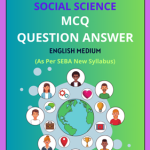SEBA Class 6 Social Science MCQ Chapter 9 What, Where, When and Why Solutions in English Medium, Class 6 Social Science Multiple Choice Question Answer to each chapter is provided in the list so that you can easily browse throughout different chapters SEBA Class 6 Social Science MCQ Chapter 9 What, Where, When and Why Question Answer and select need one.
SEBA Class 6 Social Science MCQ Chapter 9 What, Where, When and Why
Also, you can read the SCERT book online in these sections SEBA Class 6 Social Science Objective Type Solutions by Expert Teachers as per SCERT (CBSE) Book guidelines. These solutions are part of SCERT All Subject Solutions. Here we have given Assam SEBA Class 6 Social Science MCQ Solutions for All Subject, You can practice these here.
What, Where, When and Why
Chapter – 9
| MCQ |
1. What does the term ‘history’ mean?
(a) The study of plants.
(b) The study of past events.
(c) The study of stars.
(d) The study of geography.
Answer: (b) The study of past events.
2. Why do we study history?
(a) To understand current events.
(b) To learn about future predictions.
(c) To appreciate art.
(d) To know about our ancestors and past cultures.
Answer: (d) To know about our ancestors and past cultures.
3. When did the first cities emerge?
(a) Around 2500 BCE.
(b) Around 1500 CE.
(c) Around 1000 BCE.
(d) Around 500 CE.
Answer: (a) Around 2500 BCE.
4. What is the study of inscriptions called?
(a) Numismatics.
(b) Epigraphy.
(c) Archaeology.
(d) Anthropology.
Answer: (b) Epigraphy.
5. Which of the following is a written record of the past?
(a) Fossils.
(b) Inscriptions.
(c) Tools.
(d) Pottery.
Answer: (b) Inscriptions.
6. What are manuscripts?
(a) Written records on palm leaves or bark.
(b) Modern printed books.
(c) Oral stories.
(d) Stone inscriptions.
Answer: (a) Written records on palm leaves or bark
Sources of History.
7. What are the sources of history?
(a) Only written records.
(b) Only oral traditions.
(c) Written records, oral traditions, and archaeological evidence.
(d) Only archaeological evidence.
Answer: (c) Written records, oral traditions, and archaeological evidence.
8. Which of the following is an example of an archaeological source?
(a) Inscriptions.
(b) Manuscripts.
(c) Tools and pottery.
(d) Chronicles.
Answer: (c) Tools and pottery.
8. Which source tells us about the use of iron in the past?
(a) Inscriptions.
(b) Manuscripts.
(c) Coins.
(d) Archaeological evidence.
Answer: (d) Archaeological evidence.
9. What is the term used for the period before the invention of writing?
(a) Historic period.
(b) Prehistoric period.
(c) Mediaeval period.
(d) Modern period.
Answer: (b) Prehistoric period.
10. Which era is commonly used to measure historical time in India?
(a) Gregorian era.
(b) Julian era.
(c) Vikram Samvat.
(d) Islamic era.
Answer: (c) Vikram Samvat.
11. What does ‘CE’ stand for in historical dating?
(a) Christian Era.
(b) Common Era.
(c) Century Era.
(d) Current Era.
Answer: (b) Common Era.
12. Which civilization is known as the first urban civilization in India?
(a) Maurya.
(b) Gupta.
(c) Harappan.
(d) Chola.
Answer: (c) Harappan.
13. What was the main occupation of the people of the Harappan civilization?
(a) Hunting.
(b) Agriculture.
(c) Fishing.
(d) Trading.
Answer: (b) Agriculture.
14. Which river was crucial for the Harappan civilization?
(a) Ganges.
(b) Yamuna.
(c) Indus.
(d) Godavari.
Answer: (c) Indus.
15. Who is considered the founder of the Maurya Empire?
(a) Ashoka.
(b) Chandragupta Maurya.
(c) Harsha.
(d) Akbar.
Answer: (b) Chandragupta Maurya.

Hi! my Name is Parimal Roy. I have completed my Bachelor’s degree in Philosophy (B.A.) from Silapathar General College. Currently, I am working as an HR Manager at Dev Library. It is a website that provides study materials for students from Class 3 to 12, including SCERT and NCERT notes. It also offers resources for BA, B.Com, B.Sc, and Computer Science, along with postgraduate notes. Besides study materials, the website has novels, eBooks, health and finance articles, biographies, quotes, and more.




